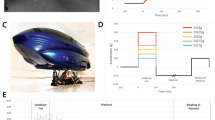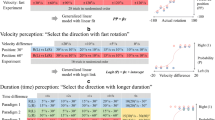Abstract
Without visual feedback, humans perceive tilt when experiencing a sustained linear acceleration. This tilt illusion is commonly referred to as the somatogravic illusion. Although the physiological basis of the illusion seems to be well understood, the dynamic behavior is still subject to discussion. In this study, the dynamic behavior of the illusion was measured experimentally for three motion profiles with different frequency content. Subjects were exposed to pure centripetal accelerations in the lateral direction and were asked to indicate their tilt percept by means of a joystick. Variable-radius centrifugation during constant angular rotation was used to generate these motion profiles. Two self-motion perception models were fitted to the experimental data and were used to obtain the time constant of the somatogravic illusion. Results showed that the time constant of the somatogravic illusion was on the order of two seconds, in contrast to the higher time constant found in fixed-radius centrifugation studies. Furthermore, the time constant was significantly affected by the frequency content of the motion profiles. Motion profiles with higher frequency content revealed shorter time constants which cannot be explained by self-motion perception models that assume a fixed time constant. Therefore, these models need to be improved with a mechanism that deals with this variable time constant. Apart from the fundamental importance, these results also have practical consequences for the simulation of sustained accelerations in motion simulators.





Similar content being viewed by others
References
Benson AJ, Spencer MB, Stott JRR (1986) Thresholds for the detection of the direction of whole-body, linear movement in the horizontal plane. Aviat Space Environ Med 57(11):1088–1096
Bles W, Groen EL (2009) The DESDEMONA motion facility: applications for space research. Microgr Sci Technol 21:281–286
Bos JE, Bles W (2002) Theoretical considerations on canal-otolith interaction and an observer model. Biol Cybern 86:191–207
Clark B, Graybiel A (1966) Factors contributing to the delay in the perception of the oculogravic illusion. Am J Psychol 79(3):377–388
Clemens IAH, de Vrijer M, Selen LPJ, van Gisbergen JAM, Medendorp WP (2011) Multisensory processing in spatial orientation: an inverse probabilistic approach. J Neurosci 31(14):5365–5377
Clément G, Moore ST, Raphan T, Cohen B (2001) Perception of tilt (Somatogravic Illusion) in response to sustained linear acceleration during space flight. Exp Brain Res 138(4):410–418
Clément G, Maciel F, Dequine O (2002) Perception of tilt and ocular torsion of normal human subjects during eccentric rotation. Otol Neurotol 23(6):958–966
Cohen MM (1976) Disorienting effects of aircraft catapult launchings II. Visual and postural contributions. Aviat Space Environ Med 47(1):39–41
Cohen MM (1977) Disorienting effects of aircraft catapult launchings III. Cockpit displays and piloting performance. Aviat Space Environ Med 48(9):797–804
Cohen MM, Crosbie RJ, Blackburn LH (1973) Disorienting effects of aircraft catapult launchings. Aviat Space Environ Med 44(1):37–39
Curthoys IS (1996) The delay of the oculogravic illusion. Brain Research Bulletin 40(5–6):410–412
de Graaf B, Bos JE, Tielemans W, Rameckers F, Rupert AH, Guedry FE (1996) Otolith contribution to ocular torsion and spatial orientation during acceleration. Technical Memorandum 96-3, Naval Aerospace Medical Research Laboratory, Pensacola, FA
Fernandez C, Goldberg JM (1976) Physiology of peripheral neurons innervating otolith organs of the squirrel monkey. III. Response dynamics. J Neurophysiol 39(5):996–1008
Glasauer S (1995) Linear acceleration perception: frequency dependence of the Hilltop illusion. Acta Otolaryngol Suppl 520:37–40
Grant PR, Haycock B (2008) Effect of jerk and acceleration on the perception of motion strength. J Aircr 45(4):1190–1197
Graybiel A, Brown RH (1951) The delay in visual reorientation following exposure to a change in direction of resultant force on a human centrifuge. J Gen Psychol 45(2):143–150
Guedry FE (1974) Psychophysics of vestibular sensation. In: Kornhuber HH (ed) Handbook of sensory physiology, vol VI. Vestibular system part 2: psychophysics applied aspects and general interpretations. Springer, Berlin, pp 3–154
Heerspink HM, Berkouwer WR, Stroosma O, van Paassen MM, Mulder M, Mulder JA (2005) Evaluation of vestibular thresholds for motion detection in the SIMONA research simulator. In: AIAA modeling and simulation technologies conference and exhibit, San Francisco, CA, AIAA 2005-6502
Holly JE (2004) Vestibular coriolis effect differences modeled with three-dimensional linear-angular interactions. J Vestib Res 14(6):443–460
Holly JE, Vrublevskis A, Carlson LE (2008) Whole-motion model of perception during forward- and backward-facing centrifuge runs. J Vestib Res 18(4):171–186
Hosman RJAW (1996) Pilot’s perception and control of aircraft motions. PhD thesis, Faculty of Aerospace Engineering, Delft University of Technology
Mayne R (1974) A systems concept of the vestibular organs. In: Kornhuber HH (ed) Handbook of sensory physiology, vol VI. Vestibular system part 2: psychophysics applied aspects and general interpretations. Springer, Berlin, pp 493–580
Merfeld DM, Young LR, Oman CM, Shelhamer MJ (1993) A multidimensional model of the effect of gravity on the spatial orientation of the monkey. J Vestib Res 3:141–161
Merfeld DM, Zupan LH, Gifford CA (2001) Neural processing of gravito-inertial cues in humans. II. Influence of the semicircular canals during eccentric rotation. J Neurophysiol 85:1648–1660
Merfeld DM, Park S, Gianna-Poulin C, Black FO, Wood S (2005) Vestibular perception and action employ qualitatively different mechanisms. I. Frequency response of VOR and perceptual responses during translation and tilt. J Neurophysiol 94(1):186–198
Merfeld DM, Park S, Gianna-Poulin C, Black FO, Wood S (2005) Vestibular perception and action employ qualitatively different mechanisms. II. VOR and perceptual responses during combined tilt and translation. J Neurophysiol 94(1):199–205
Park S, Gianna-Poulin C, Black FO, Wood S, Merfeld DM (2006) Roll rotation cues influence roll tilt perception assayed using a somatosensory technique. J Neurophysiol 96(1):486–491
Reid LD, Nahon MA (1985) Flight simulation motion-base drive algorithms: part 1—developing and testing the equations. Tech Rep 296, Institute for Aerospace Studies, University of Toronto
Seidman SH, Telford L, Paige GD (1998) Tilt perception during dynamic linear acceleration. Exp Brain Res 119(3):307–314
Soyka F, Robuffo Giordano P, Beykirch KA, Bülthoff HH (2011) Predicting direction detection thresholds for arbitrary translational acceleration profiles in the horizontal plane. Exp Brain Res 209(1):97–107
Vingerhoets RAA, Medendorp WP, van Gisbergen JAM (2006) Time course and magnitude of illusory translation perception during off-vertical axis rotation. J Neurophysiol 95(3):1571–1587
Wright WG, Glasauer S (2006) Subjective somatosensory vertical during dynamic tilt is dependent on task, inertial condition, and multisensory concordance. Exp Brain Res 172(3):310–321
Young LR, Meiry JL (1968) A revised dynamic otolith model. Aerosp Med 39(6):606–608
Zaichik LE, Rodchenko V, Rufov IV, Yashin YP, White AD (1999) Acceleration perception. In: AIAA modeling and simulation technologies conference and exhibit, Portland, OR, AIAA-99-434, pp 512–520
Author information
Authors and Affiliations
Corresponding author
Rights and permissions
About this article
Cite this article
Correia Grácio, B.J., de Winkel, K.N., Groen, E.L. et al. The time constant of the somatogravic illusion. Exp Brain Res 224, 313–321 (2013). https://doi.org/10.1007/s00221-012-3313-3
Received:
Accepted:
Published:
Issue Date:
DOI: https://doi.org/10.1007/s00221-012-3313-3




